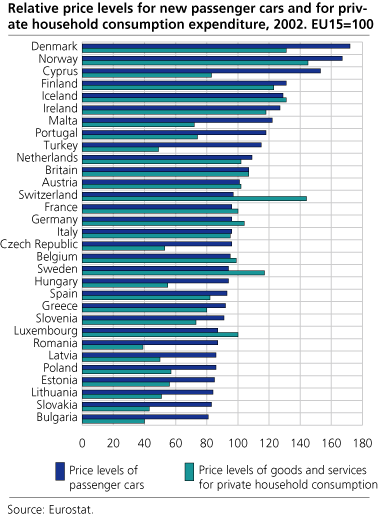Content
Published:
This is an archived release.
High price levels in Denmark and Norway
In 2002, Norway had the second highest relative price level of passenger cars in Europe, according to a survey carried out within the framework of the European Comparison Programme. Norway's relative price level was 67 per cent above the average of the 15 EU member countries but still behind Denmark, which comes out on top among the 31 participating countries. In the Nordic countries, Sweden stands out as the only country with a relative price level for passenger cars below the EU average.
The Statistical Office of the European Commission, Eurostat, recently released the results of the survey. The input price data reflects the prices actually paid by the customer, including taxes.
Differences in technical specifications, standard equipment and discount practices are factors that complicate an international price level comparison of cars. Eurostat has tried to take account of differences in technical specifications and standard equipment, but discounts remain unaccounted for.
Denmark and Norway on top
The relative price level varies from 81 per cent of the EU average in Bulgaria to 175 per cent in Denmark. This implies that the relative price level for passenger cars is about twice as high in Norway and Denmark as in Bulgaria. Finland and Iceland are also among the countries with a high relative price level, whereas Sweden is the only Nordic country that comes out below the EU average.
Among the 15 current EU member countries, Denmark, Finland, Ireland, Portugal and the Netherlands have the highest taxes on new passenger cars. Norway has high car taxes as well. The price level indices do reflect this, but the relationship between tax and price levels is not quite clear-cut. Other possible reasons behind international price level differences are differences in cost levels, profit margins and competition, exchange rate movements and diverging technical requirements.
Relative price levels for passenger cars and the general price level
Comparing the relative price level of a given product group with the relative price level of private household consumption expenditure as a whole, provides an interesting perspective. The latter is then assumed to reflect the 'general' price level of each country. The chart below shows the price level indices for passenger cars and for the total of all goods and services for final household consumption. A possible interpretation of this chart is to regard the general price level as an estimate of a country's level of costs. Cyprus, Malta, Turkey and the EU acceding countries in Eastern Central Europe, as well as Denmark and Norway, are countries where the price level of passenger cars lies considerably above the general price level. The opposite is the case in Switzerland, Sweden and Luxembourg.
Firm conclusions based on an analysis of this kind should only be drawn where the two indices deviate substantially.
Read more in Eurostat s " Statistics in Focus "
The statistics is now published as Comparison of price levels in Europe.
Contact
-
Statistics Norway's Information Centre
E-mail: informasjon@ssb.no
tel.: (+47) 21 09 46 42

